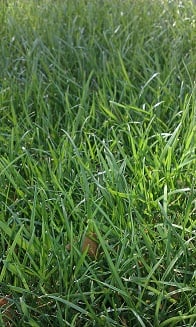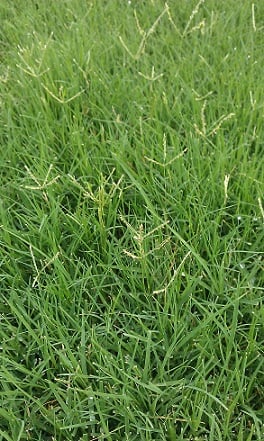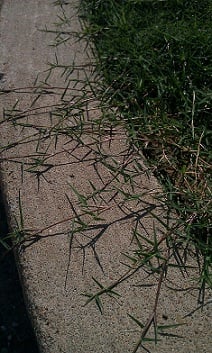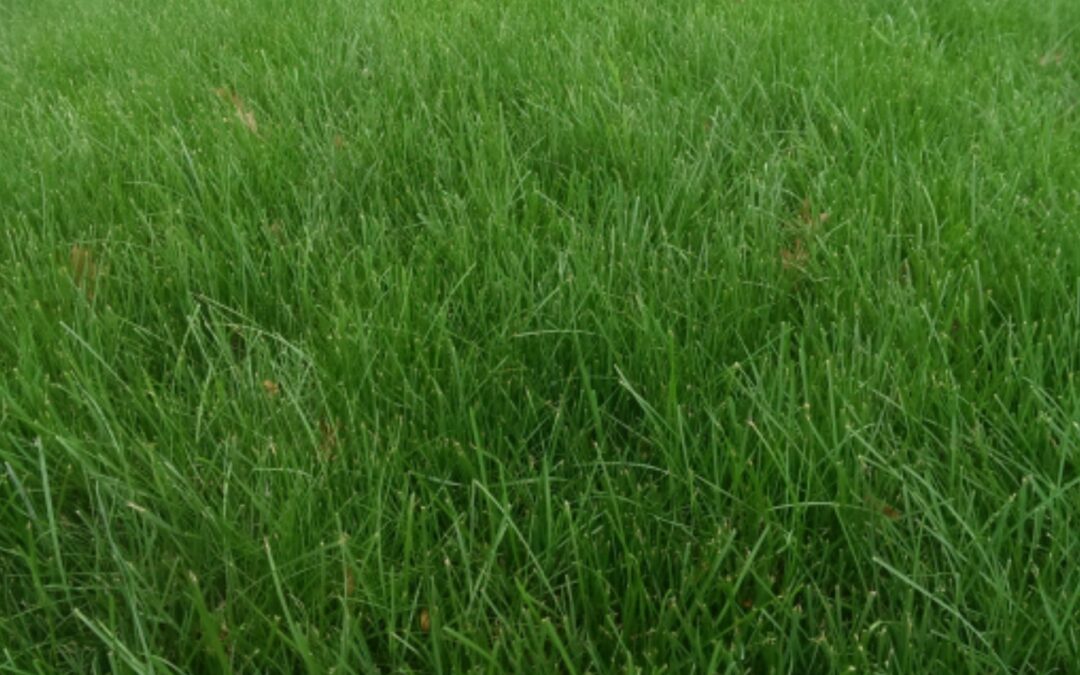Grass Types
What’s the best grass for the Tulsa area? Bermudagrass, zoysia, and fescue are the three most common types. Here’s what you need to know about growing grass in Tulsa and surrounding areas:

Bermudagrass
Full-sun, warm-season grass of choice in Tulsa and other warm climates (pictured, right.)
To identify bermuda
• Green in the summer and brown in the winter. Will also turn brown in drought conditions.
• Spreads by underground rhizomes and aboveground stolons, so you may see “runners” growing out over your sidewalk or driveway (below, left.)
• There are many different varieties of bermuda, from course-bladed common bermuda to fine-bladed cultivars (cultivated varieties) like Tifway, so your neighbor’s bermuda may not look exactly like yours.
• Bermuda should be mowed short – ½” to 2.5” depending on the variety and the time of year. If it gets too long, you will see seed heads. Sometimes our clients think bermuda seed heads (pictured, right) are weeds. They are not, but if you see them, you aren’t mowing often enough.
Good bermuda qualities
• Can take a lot of abuse, which is why it’s ideal for sports fields and golf courses.
• Drought and heat tolerant in the southern half of the United States.
• If it’s healthy, thick, and properly-mowed, bermuda can choke out almost any weeds.
• Although it turns brown and takes a nap in the winter, it’s just dormant, not dead. In the spring, it wakes up and turns green again.
• Bermuda is resilient. Although it may also turn brown and dormant during a drought, it will green up again when it gets water. Going dormant is its way of conserving energy.
• One of the fastest-growing warm-season turf grasses – can grow 24 hours per day when low temps are in the 70’s.
• Easily established from sod or sprigs.
• Damaged areas can easily repair themselves – the surrounding bermuda will fill it in.
• Will grow in poor soils


Bad bermuda qualities
• Turns brown in the winter. Not too attractive, especially if you’re from up north and used to Kentucky bluegrass.
• Can also turn brown and go dormant in drought conditions with no water. Keeping bermuda green during a drought will raise your water bill significantly!
• Needs a lot of mowing during the hot growing season, a minimum of once per week, sometimes every 4 or 5 days. Assuming, that is, that it’s getting sufficient water.
• Best established from sod or sprigs, not seed, so it’s somewhat more expensive to put in a new lawn than it would be if you could just plant seed. Most of the finer cultivars are not available in seed, and some of them are sterile, producing no seeds.
• Although not common, winter injury to bermuda can occur when conditions are just right, resulting in areas of dead grass.
• Needs more fertilizer than other grasses for good color. It prefers deep, well-drained soil.
• Will not grow in shade. Some varieties may be more tolerant of partial shade, but it will never look as good as bermuda in full sun.
To identify fescue
• Will be green when bermudagrass is brown and dormant. (If other people have brown grass in the winter, and yours is green, it’s fescue.)
•Fescue does not spread, so you won’t see runners going into the flowerbeds or out onto your driveway.
• If fescue is being mowed correctly, it will be twice as tall as bermuda. In Tulsa, you may see fescue under trees in the shade, while the rest of the lawn is bermuda. So if you see a brown lawn in the early spring with green grass under the trees, it’s a bermuda lawn with fescue planted in the shade areas
Bad fescue qualities
• Will lose some of it each year, due to high temps in Tulsa.
• May need to be watered lightly every day in the heat of the summer just to cool it off, and also watered deeply twice weekly to meet its water requirement.
• Must be overseeded each fall.
• Sometimes doesn’t look too good in the hot summer (pictured, right – fescue in Tulsa during drought & temps consistently over 100 degrees.)
• Will not grow in total, heavy shade. All grass needs light. Bear in mind that we grow fescue in the shade here in Tulsa because of its heat intolerance. When we seed it in the fall, the leaves are coming off the trees, and the fescue gets sun for a long period – long enough to store carbohydrates to get through the hot summer. That’s another reason it looks poorly in the summer – lack of sun.
• Needs to be mowed earlier in the season since it’s green and growing before the Bermuda is even out of dormancy. Fescue’s growing season begins in September (which is when you seed) so you will have to keep mowing it later in the year.
• Not tolerant of heavy traffic
• Does not spread and can’t repair itself if you have a damaged area.

Ryegrass
A perennial cool-season grass, sometimes used in small percentages in fescue blends to seed or overseed in shade areas in Tulsa in the fall. Ryegrass is also used to overseed dormant bermudagrass lawns in the fall so the lawns will be green throughout the winter.
To identify ryegrass
However, if you see green grass in a full sun area in the fall, winter or very early spring, it’s most likely rye that has been seeded over the dormant bermuda, to give the appearance of a green lawn all winter.
A lot of the fescue you see under trees and in other shady areas has a small percentage of rye mixed in with it because rye germinates so quickly that it holds the fescue seed in place.
Good Ryegrass Qualities
Can germinate in as little as 5 days. Grows very well in the winter. You can seed rye over your dormant bermuda lawn for a green lawn all winter.

